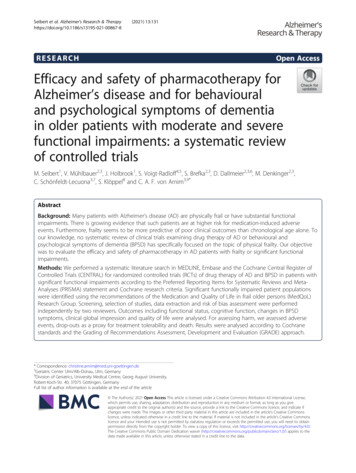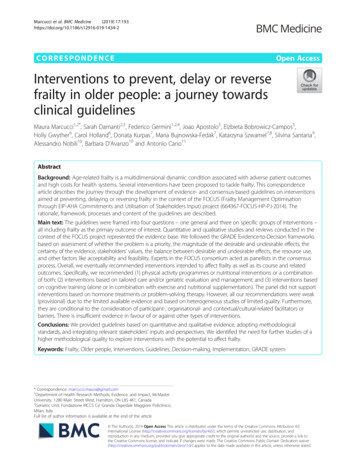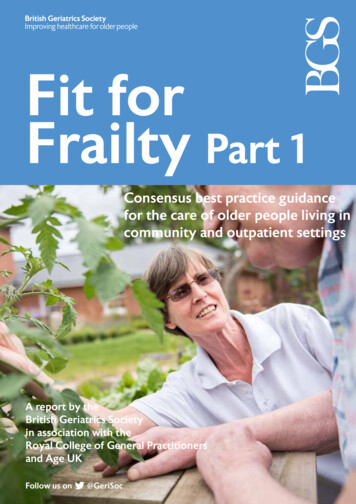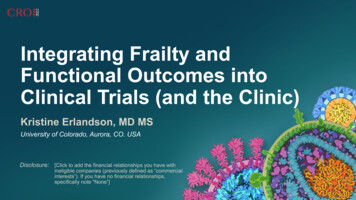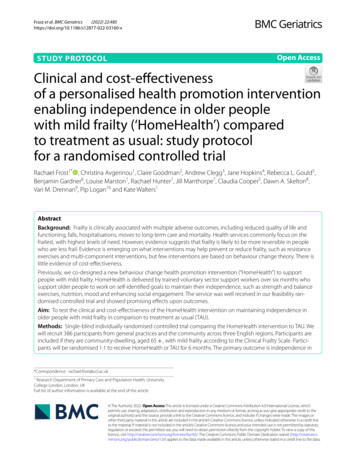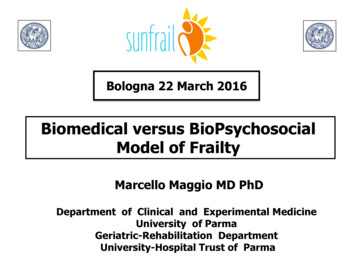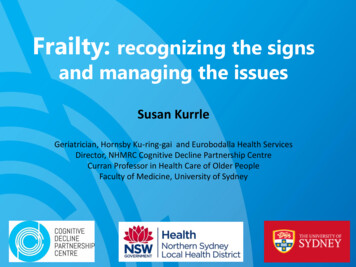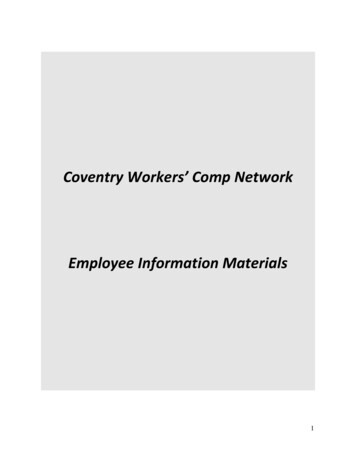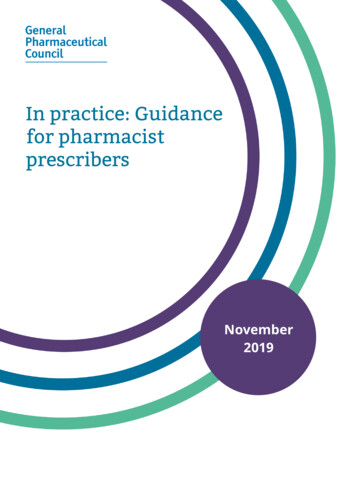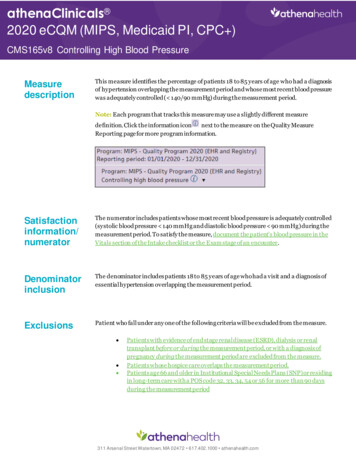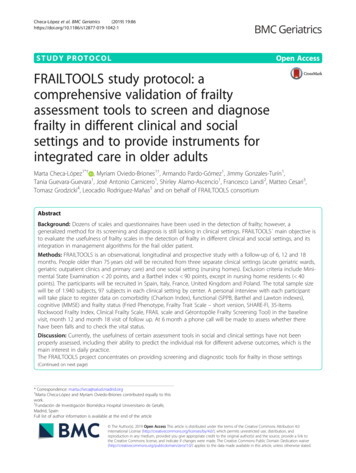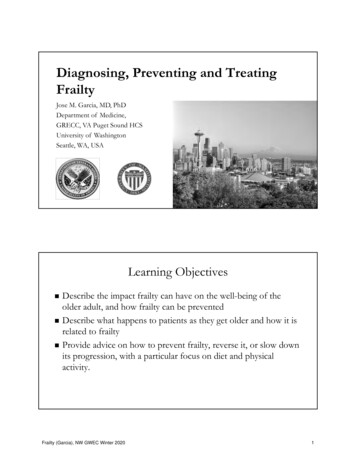
Transcription
Diagnosing, Preventing and TreatingFrailtyJose M. Garcia, MD, PhDDepartment of Medicine,GRECC, VA Puget Sound HCSUniversity of WashingtonSeattle, WA, USALearning Objectives Describe the impact frailty can have on the well-being of theolder adult, and how frailty can be preventedDescribe what happens to patients as they get older and how it isrelated to frailtyProvide advice on how to prevent frailty, reverse it, or slow downits progression, with a particular focus on diet and physicalactivity.Frailty (Garcia), NW GWEC Winter 20201
Case presentation 68 yo female with a history of severe COPD on home O2intermittently,Head and neck cancer s/p resection XRT in 2018, currently inremissionHas osteoporosis, on bisphosphonates since 2104, depressionComplaints of 11% weight loss over the last year, dysphagia,fatigue, SOB, poor appetite andLives with partner in rural area, sedentary, smokes 5 cig/dayCase presentation On Ca D 500mg/400 IU daily, Bupropion, Zoledronic acidyearly, albuterol, tiotropium, nometasoneVitals: 135/75, 102, 22, O2 sat 88% on room air, BMI 16Dry oral mucosae, actinic dermatitis over the neck, well healedscarTachycardic, decreased breath sounds B, no wheezingNo edemaUnable to stand from chair without using her armsWalking speed: 12 seconds to walk 15ftFrailty (Garcia), NW GWEC Winter 20202
Case presentation Is she frail? How can we diagnose frailty in her case?What preventive measures or treatments, if any, should weconsider?Paradigms of Frailty Increased vulnerability to stressors and adverse outcomes seenoften late in lifeFrailty as accumulation of deficits: “the more things that are wrong, themore likely that person is frail” (Rockwood 2007) Frailty as a biologic syndrome of decreased reserve resulting fromcumulative declines across multiple physiologic systems (Fried et al.2001) Fried et al., Frailty in older adults: evidence for a phenotype, J Gerontol A Biol Sci Med Sci 2001.Frailty (Garcia), NW GWEC Winter 20203
Risk Factors for Frailty Older ageLower educational levelCurrent smokerCurrent use of postmenopausal hormone therapyAfrican-American or Hispanic ethnicityNot marriedDepression, or use of antidepressantsIntellectual disabilityDiseases associated with increased risk of frailty COPDChronic inflammatory diseasesHip fracturesPressure ulcers and chronicwoundsAIDS, Tuberculosis, otherchronic infectionsFrailty (Garcia), NW GWEC Winter 2020 Congestive Heart FailureESRDDiabetesDementiaDepressionAdvanced cancer4
Frailty TrajectoryFerrucci L et al. Biomarkers of frailty in older persons. J Endocrinol Invest 2002;25(10 Suppl):10-15Social Factors and FrailtyAndrew MK (2010) Social vulnerability in old age. Brocklehurst’s Textbook of Geriatrics and Clinical GerontologyFrailty (Garcia), NW GWEC Winter 20205
Frailty and MCI Cognition is often excludedfrom assessments or frailtydefinitions.However, frailty is associatedwith an increased risk of mildcognitive impairment and anincreased rate of cognitivedecline with agingFrailtyCognitiveimpairmentPoor outcomesPrevalence and Relevance of Frailty Up to 15% of community dwelling older adults, higher in assistedliving communities, cancer patients ( 40%)Predicts hip fractures, disability, hospitalization, surgical outcomesMortality increases (1.7-5 times depending on the definition)Frailty (Garcia), NW GWEC Winter 20206
Physical Frailty Phenotype (PFP) Weight loss (more than 10 lbs or 5% over the previous year)Weakness (grip strength)Exhaustion (self-report)Walking Speed ( 6-7s to walk 15 feet)Physical Activity ( 383ʈ or 270ʇ Kcals/week)Not Frail: 0 Intermediate: 1-2 Frail: 3 Fried et al., Frailty in older adults: evidence for a phenotype, J Gerontol A Biol Sci Med Sci, 2001.Frailty Index Ratio of deficits present out ofthe total number of possibledeficits, gives a continuous scorefrom total fitness (0) to totalfrailty (1)0-0.1: not frail 0.11-0.2: vulnerable 0.21-0.45: frail 0.46-1: Most frail Blodgett et al. Archives of Gerontology and Geriatrics 60 (2015) 464–470Frailty (Garcia), NW GWEC Winter 20207
FRAIL (1 Yes, 0 No; 1-2 prefrail, 2 Frail) Fatigue ("Have you felt fatigued? Most or all of the time over thepast month?")Resistance ("Do you have difficulty climbing a flight of stairs?")Ambulation ("Do you have difficulty walking one block?")Illnesses (“Do you have: hypertension, diabetes, cancer, chroniclung disease, heart attack, CHF, angina, asthma, arthritis, stroke,and kidney disease?”) Five or greater 1, fewer than 5 0Loss of weight (“ 5% weight loss in the past year?”)Study of Osteoporosis (SOF Index)(1 Yes, 0 No) Requires at least two of three componentsweight loss (5% over the previous year) The inability to rise from a chair 5 times without the use of arms Self-reported reduced energy level ("Do you feel full of energy?, or‘‘Over the past week or so, did you feel like you could not get going 3 ormore days?") Frailty status was defined as robust (0 components), prefrail(previously referred to as ‘‘intermediate’’; one component), andfrail (2 or more components).Frailty (Garcia), NW GWEC Winter 20208
BackgroundThe prevalence of physical frailty according to groups for sex, age andphysiotherapy indicationFried’s physical frailty phenotypeFrailty Index/model of deficit accumulationTobias Braun et al. BMJ Open 2019;9:e027768 2019 by British Medical Journal Publishing GroupFrailty (Garcia), NW GWEC Winter 20209
Frequency of physical frailtyphenotype deficits in thesubgroups of participants.Tobias Braun et al. BMJ Open 2019;9:e027768 2019 by British Medical Journal Publishing GroupFrailty and OutcomesRockwood et al. Scientific reports 2017Blodgett et al. Archives of Gerontology and Geriatrics (2015)Kiely et al. JAGS 2009Frailty (Garcia), NW GWEC Winter 202010
Frailty Screening inSubspecialtiesWaltson et al. Clin Geriatr Med. 2018Mechanisms of Frailty Hormones (sex steroids, GH, cortisol, Vit D)Inflammation (IL-6, hs-CRP, WBC and monocyte count)SarcopeniaPotential as therapeutic targets is unknownFrailty (Garcia), NW GWEC Winter 202011
Assessment 70 years-old and those with weight loss 5% should bescreenedComorbiditiesDepression Malignancy or hematologic disease Rheumatologic disease – Polymyalgia rheumatica, vasculitis Endocrinologic disease – Hyper- or hypothyroidism, diabetes mellitus Cardiovascular or renal disease Nutritional deficits – Vitamin deficiencies Neurologic disease – Parkinson disease, vascular dementia Assessment Physical examination should include assessment of the patient'sfunction walking speed, grip, chair standComplete blood countBasic metabolic panelLiver biochemical testsVitamin B12Vitamin DThyroid-stimulating hormone (TSH)Frailty (Garcia), NW GWEC Winter 202012
Goals for Frailty Interventions Improve QOLPrevent worsening chronic disease and functional declineReduce risk for adverse outcomesRisk assessment to guide therapeutic options and goal settingFrailty and BMIBlaum et al. JAGS 2005Frailty (Garcia), NW GWEC Winter 202013
Exercise Increased mobility, enhanced performance of activities of dailyliving (ADLs), improved gait, decreased falls, improved bonemineral density, and increased general wellbeingStart low and go slow and individualized prescription Consider physical therapy consult, focusing on functional exercises Goals is 150 minutes per week of moderate-intensity aerobic activity(rarely met) Patients will also benefit from balance and strength training OT for those with ADLs limitationsExercise IntensityLight 3.0 METsModerate3.0-6.0 METsVigorous 6.0 METS Walking slowly Sitting using computer Standing light work (cooking, washingdishes) Fishing sitting Playing most instruments Walking very brisk (4 mph) Cleaning heavy (washing windows,vacuuming, mopping) Mowing lawn (power mower) Bicycling light effort (10-12 mph) Bad minton recreational Tennis doubles Hiking Jogging at 6 mph Shoveling Carrying heavy loads Bicycling fast (14-16 mph) Basketball game Soccer game Tennis e/Frailty (Garcia), NW GWEC Winter 202014
is the exercise and physical activity campaign for older adults from the National Institute on Aging at NIHwww.nia.nih.gov/Go4LifeGo4Life is a registered trademark of the US Department of Health and Human Services.U.S. Physical Activity Guidelines for AmericansFor substantial health benefits, adults should do at least 150 minutes (2 hours and 30 minutes) a week of moderateͲintensity physical activity OR 75 minutes (1 hour and 15 minutes) a week of vigorousͲintensity aerobic physical activity, OR an equivalent combinationof moderateͲ and vigorousͲintensity aerobic activity. Aerobic activity should be performed in episodes of at least 10 minutes, and preferably, it should be spread throughout the week.Frailty (Garcia), NW GWEC Winter 202015
The 4 Types of Exercises Recommended for Adults 50 rance Exercises 9 Increase your breathing and heart rate and improve the health of your lungs, heart and circulatory system. 9 Examples: Swimming, running, brisk walking, biking, dancing, basketball.9 Endurance activities make it easier to walk uphill and not get short of breath push your grandchild on a swingFrailty (Garcia), NW GWEC Winter 202016
Strength Exercises 9 Use weight or resistance to increase muscle strength. 9 Examples: lifting weights, using resistance bands, leg lifts, squats, arm curls.9 Increased muscle strength can help you Climb stairs Carry groceries Open jarsBalance Exercises 9 Improve your ability to control your body’s position, whether moving or still. 9 Examples: standͲonͲoneͲfoot, heelͲtoͲtoe walk, tai chi.9 Good balance can help Prevent falls Stand on tiptoe without teetering Walk on uneven sidewalks without fallingFrailty (Garcia), NW GWEC Winter 202017
Flexibility Exercises 9Use stretching to help you stay flexible and limber. 9Examples: shoulder stretch, back of leg stretch, calf stretch, ankle stretch, yoga.9Being more flexible can help you Feel less stiff when getting out of bed Bend over to tie your shoe or put on socks Button a shirt or blouseHow to Exercise Safely (8) Check with your doctor or healthcare provider if you have specific health conditions or if you are going to significantly increase your level of effort.Frailty (Garcia), NW GWEC Winter 202018
How to Exercise Safely (4)When doing Endurance exercise Listen to your body. Your breathing may become faster, but you should still be able to talk.How to Exercise Safely (5)When doing Strength exercise Don’t exercise the same muscle group on any 2 days in a row.Frailty (Garcia), NW GWEC Winter 202019
How to Exercise Safely (6)When doing Balance exercise Have that sturdy chair handy or a person nearby to hold on to for your balance exercises if you feel unsteady.Frailty (Garcia), NW GWEC Winter 202020
Start Moving! (4) Click on See Workout Videos and try the 10Ͳ 15Ͳ 20Ͳ or 60Ͳminute sample workouts.** **Also available on YouTubeFrailty (Garcia), NW GWEC Winter 202021
Keep Going! (1) Use these Go4Life tracking tools to(1) track your exercise activities and (2) see your progress Nutrition Cachexia (cancer, COPD, CHF, CKD, liver disease, infections,etc)Food insecurity/accessChewing/swallowing problemsOral healthDrug-inducedGI problemsDepression, dementiaDietary restrictionsFrailty (Garcia), NW GWEC Winter 202022
Malnutrition Two or more of the following six characteristics:Insufficient energy intake Weight loss Loss of muscle mass Loss of subcutaneous fat Localized or generalized fluid accumulation that may mask weight loss Diminished functional status as measured by handgrip strength Protein intake 1-1.2 g/Kg (IOM 0.8 g/kg)Caloric needs based on physical activity, sex and body weightNutrition: Caloric/Protein supplements Limited data on efficacy and safetyDietitian referralConsidered in specific scenarios Weight loss, cachexia, low BMI, malnutrition, critically illTake into account: Financial burden, side effects (diarrhea, nausea, hyperglycemia)Frailty (Garcia), NW GWEC Winter 202023
Meta-analysis of trials of oral protein and energy supplementation inolder people,(excluding cancer or critical care patients) Body weight increase 2.2% on averageMortality was reduced in undernourished patients (RR 0.79, 95% CI 0.640.97)The risk of complications was reduced in 24 trials (RR 0.86, 95% CI 0.75 to0.99)Few trials suggest any functional benefitNo difference in length of stayAdverse effects included nausea or diarrheaCochrane Systematic Review, 2009Nutrition-Calcium and Vit D Calcium (1.2 g elemental Ca daily)Vit DGoal 25 OH Vit D level 30ng/mL (IOM recommends at least 20ng/mL) At least 800-1000 IU (often 2,000 IU) daily are needed for maintenance Higher doses are usually required for replacement Frailty (Garcia), NW GWEC Winter 202024
Obesity treatment in older patients Energy restriction with a hypocaloric diet results in the loss ofapproximately one-quarter of lean mass per unit weight, whichcould worsen sarcopenia and osteopeniaCalorie restriction without resistance training leads to the loss ofmuscle mass and loss of handgrip strength of up to 4.6% and 1.7kg, respectivelyObesitytreatmentin theElderlyVillareal et al. N Engl J Med. 2011Frailty (Garcia), NW GWEC Winter 202025
Obesitytreatmentin theBody weight (Kg)ElderlyMuscle mass(cm Fat mass (Kg)1.2-7.1-1.8-6.3Hip BMD-7-2713-11Gait speed .73.47.9Villareal et al. N Engl J Med. 2011Obesity treatment andfrailtyVillareal et al. N Engl J Med. 2017Frailty (Garcia), NW GWEC Winter 202026
Medications Review medications (interactions, side effects)Testosterone deficiency in men (controversial)Men with persistently and unequivocally low T levels, symptoms ofhypogonadism (low libido, ED) and no contraindications No consistent effect of T. on fatigue or physical function GH (not indicated)Orexigenic agents: megestrol, dronabinol limited efficacy, side effectsT Trials (Snyder PJ. Endocr Rev. 2018) Testosterone treatment causing levels to go from unequivocallylow at baseline to mid-normal for young men for 12 months:Increased sexual activity, sexual desire, and erectile function Increased the 6MWD (but not in those with low walking speed) Did not increase cognition or energy but slightly improved mood anddepressive symptoms. Increased hemoglobin, BMD, coronary artery non-calcified plaquevolume Was not associated with CV or prostate adverse events A larger safety trial is ongoing (TRAVERSE) Frailty (Garcia), NW GWEC Winter 202027
Case presentation 68 yo female with a history of severe COPD on home O2intermittently,Head and neck cancer s/p resection XRT in 2018, currently inremissionHas osteoporosis, on bisphosphonates since 2104, depressionComplaints of 11% weight loss over the last year, dysphagia,fatigue, SOB, poor appetite andLives with partner in rural area, sedentary, smokes 5 cig/dayCase presentation On Ca D 500mg/400 IU daily, Bupropion, Zoledronic acidyearly, albuterol, tiotropium, nometasoneVitals: 135/75, 102, 22, O2 sat 88% on room air, BMI 16Dry oral mucosae, actinic dermatitis over the neck, well healedscarTachycardic, decreased breath sounds B, no wheezingNo edemaUnable to stand from chair without using her armsWalking speed: 12 seconds to walk 15ftFrailty (Garcia), NW GWEC Winter 202028
Case presentation Is she frail? How can we diagnose frailty in her case?What preventive measures or treatments, if any, should weconsider?Assessment Physical examination should include assessment of the patient'sfunction walking speed, grip, chair stand Grip 18 KgComplete blood count WNLBasic metabolic panel CO2 35 mEq/LLiver biochemical tests WNLVitamin B12 WNLVitamin D 16 ng/mLThyroid-stimulating hormone (TSH) 12 micro IU/mLFrailty (Garcia), NW GWEC Winter 202029
Assessment 70 years-old and those with weight loss 5% should bescreened WEIGHT LOSSComorbiditiesDepression YES Malignancy or hematologic disease YES Rheumatologic disease – Polymyalgia rheumatica, vasculitis Endocrinologic disease – Hyper- or hypothyroidism, diabetes YES Cardiovascular or renal disease Nutritional deficits – Vitamin deficiencies VIT D DEF Neurologic disease – Parkinson disease, vascular dementia Physical Frailty Phenotype (PFP) Weight loss (more than 10 lbs or 5% over the previous year)Weakness (grip strength)Exhaustion (self-report)Walking Speed ( 6-7s to walk 15 feet)Physical Activity ( 383ʈ or 270ʇ Kcals/week)Not Frail: 0 Intermediate: 1-2 Frail: 3 Frailty (Garcia), NW GWEC Winter 2020Wang et al. J Orthop Sports Phys Ther. 2018 Sep;48(9):685-693Ainsworth BE, et al. Compendium ofPhysical Activities: an update of activity codes and MET intensities. Medicine and Science in Sports andExercise. 2000;32:S498–S516Fried et al., Frailty in older adults: evidence for a phenotype, J Gerontol A Biol Sci Med Sci, 2001.30
Physical Frailty Phenotype (PFP) Weight loss (more than 10 lbs or 5% over the previous year)Weakness (grip strength)Exhaustion (self-report)Walking Speed ( 6-7s to walk 15 feet)Physical Activity ( 383ʈ or 270ʇ Kcals/week)Not Frail: 0 Intermediate: 1-2 Frail: 3 Wang et al. J Orthop Sports Phys Ther. 2018 Sep;48(9):685-693Ainsworth BE, et al. Compendium ofPhysical Activities: an update of activity codes and MET intensities. Medicine and Science in Sports andExercise. 2000;32:S498–S516Fried et al., Frailty in older adults: evidence for a phenotype, J Gerontol A Biol Sci Med Sci, 2001.Frailty Index Ratio of deficits present out ofthe total number of possibledeficits, gives a continuous scorefrom total fitness (0) to totalfrailty (1)14/46 0.30-0.1: not frail 0.11-0.2: vulnerable 0.21-0.45: frail 0.46-1: Most frail Blodgett et al. Archives of Gerontology and Geriatrics 60 (2015) 464–470Frailty (Garcia), NW GWEC Winter 202031
Frailty Interventions Medication reviewReferral to Nutrition determined she was not meeting caloricneeds: Nutritional supplementsReferral to pulmonary for optimization of COPD managementPulmonary rehab and exercise program guided by PTVit D replacement (Ergocalciferol 50,000 IU weekly for 3 months)Started smoking cessation programLevothyroxine 25 mcg dailyArtificial salivaConclusions Frailty is common in the elderly and is associated withsignificantly higher morbidity and mortalityDiagnosing frailty and pre-frailty using one of the instrumentsavailable can be useful in risk stratification and in identifyingpatients who will most benefit from treatmentManage comorbidities taking into account overall status and goalsof careLong-term multi-domain lifestyle intervention of nutritioncounseling and physical activity and multicomponent strategiesare likely to benefit these patients.Frailty (Garcia), NW GWEC Winter 202032
Rockwood et al. Scientific reports 2017 Blodgett et al. Archives of Gerontology and Geriatrics (2015) Kiely et al. JAGS 2009 Frailty (Garcia), NW GWEC Winter 2020 10. Frailty Screening in Subspecialties . Consider physical therapy consult, focusing on functional exercises
